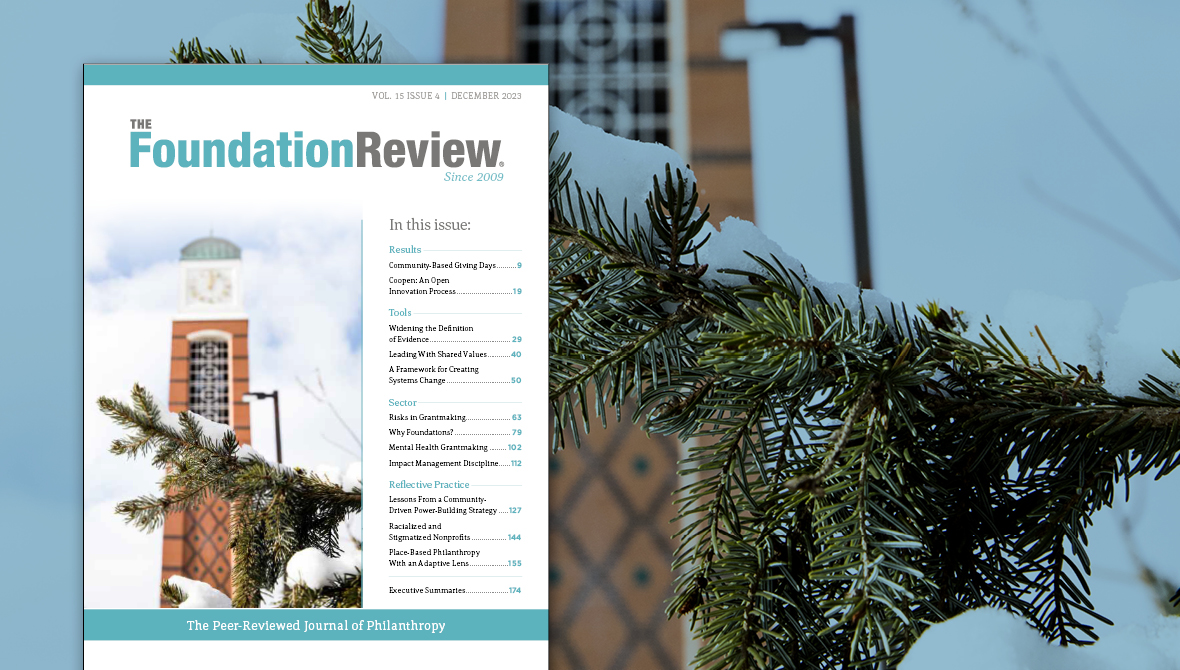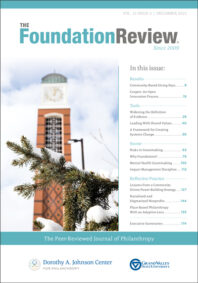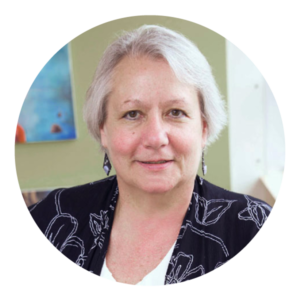Inside The Foundation Review, Volume 15, Issue 4


 The Foundation Review is wrapping up its fifteenth year with a particularly hefty issue. The dozen articles in this issue run the gamut from reports on tightly defined research and evaluation to broad theoretical discussions about the nature of philanthropy and foundations.
The Foundation Review is wrapping up its fifteenth year with a particularly hefty issue. The dozen articles in this issue run the gamut from reports on tightly defined research and evaluation to broad theoretical discussions about the nature of philanthropy and foundations.
As we wrap up Volume 15, I’d like to extend my deep gratitude to the reviewers for this volume. The list of those who reviewed an article in the past year is included at the back of this issue. Our volunteer reviewers are the lifeblood of the journal. Their thoughtful guidance to the authors contributes immeasurably to the quality.
In addition to concluding the fifteenth year of publication, this issue also marks the conclusion of my role as editor-in-chief. I retired as executive director of the Johnson Center in late 2022 but committed to finishing this volume. I launched the journal in 2009, largely out of my frustration with the lack of a platform for foundations to learn from each other. In my role as director of evaluation at the W.K. Kellogg Foundation, I saw millions of dollars spent annually on evaluations that were only partially shared, if at all. I was also seeing the field become more professional, with a recognition that being a grantmaker does have specialized knowledge and skills required to be effective. The journal was launched with the mission of supporting those professionals by building knowledge. The peer-review process, while imperfect, is still the standard for how we assess the quality of new knowledge — hence the peer-reviewed journal.
Over the last fifteen years, the field of philanthropy has continued to grow and diversify. DAFs have grown in significance, impact investing has begun to take hold, racial equity has become a key consideration, and the role of philanthropy in changing systems has been acknowledged. (The annual 11 Trends in Philanthropy report published by the Johnson Center highlights many of the changes in the field.) The professionalization of the field has continued, with a robust competency model for program officers now available.
I have had a first-class team working with me. My gratitude to Pat Robinson, associate editor, who has done an amazing job of managing many of the moving parts of the journal. Karen Hoekstra does our design and layout, making us all look good. Domenica Trever is a copyeditor extraordinaire, working with our authors to make sure their meaning is clear — not to mention properly cited and punctuated and spelled correctly.
I know the next fifteen years will continue to be exciting. I’m proud of what the journal has accomplished and am confident that it will flourish under the leadership of Hanh Cao Yu. Volume 16 will be comprised of two special issues that she will edit, while she and the Johnson Center take time for a strategic refresh. I encourage you to reach out to Hanh at TFReditorinchief@gvsu.edu with ideas or feedback. I wish her — and all of you — the best.


Teri Behrens, Ph.D.
Editor in Chief, The Foundation Review
Bhati and Burk focus on the rise in giving days led by community foundations. The number of giving days increased from two led by community foundations in 2009 to more than seventy in the 2020s. Community foundations in small towns raised more per capita than those in metropolitan areas. This study highlights the need and opportunity for additional research to support this fundraising tactic.
As the 2030 target date to achieve the United Nations Sustainable Development Goals looms ahead, innovative approaches to making progress are needed. Bersanetti, Masciadri, Caramia, and Toscano share the results of Coopen, an approach to fostering the development and implementation of innovative solutions in Africa. The Coopen projects, a joint effort of two financial institutions, have achieved goals in sustainable food and agriculture and increased the knowledge and competencies of health care workers, leading to improved services and the promotion of healthy lifestyles. Continued innovation in service of achieving the SDGs is sorely needed.
James and Hilliard describe a process of identifying and applying equity considerations in the evidence considered for strategy development in a large, national foundation. A “common evidence base” — primarily a database library — enabled a synthesis of what was currently known, the edges of the foundation’s understanding, and emerging questions. It helped to identify gaps, which allowed testing of ways to bring more to the foundation and build that common evidence. The aperture of evidence was broadened to recognize that all information has some bias, and that bias can be mitigated by a robust consideration of a broad variety of information. This widened aperture is key to advancing understanding, not just collecting data.
While philanthropy is very value-laden work, funders and nonprofits rarely explore the match between their values. Maurana, Raymond, Stawski, Kerschner, and Rahn describe the Kern Family Foundation’s partnership with the Medical College of Wisconsin and how it was enhanced through a charter of principles. Creating a charter of principles shared by funder and grantee can establish a common language and understanding of the key priorities and principles guiding the funded work. This tool might help to reduce the friction between funders and nonprofits.
Many foundations seek to change systems in order to achieve sustainable outcomes. This article draws on a system-change framework developed by the Nicholson Foundation as part of a 20-year initiative to substantively change the state of New Jersey’s health and social welfare systems. Brown and Rosser introduce the seven components of the model: performance measurement, system expertise, nurturing partnerships and collaboration, utilizing complementary approaches, scaling and replicating promising practices, building organizational capacity, and developing leaders. This article provides another tool for those funders seeking to engage in systems change.
Grants are an investment, and like all investments carry risks. Archibald, Tajaddini, and Dunkley explore grant risk across two common approaches to grantmaking: an open approach invitation for applications for funding and a closed approach, whereby foundations identify suitable interventions to fund. Based on 34 interviews with Australian foundation directors and grant staff, the authors found management or execution risks were seen to be of major concern. Assessment risks and internal risks were also a significant source of decision uncertainty within most type of foundations. The researchers provide a framework for understanding risk in the nonprofit arena.
Whether or not large private foundations should even exist is a socio-political question that is often raised. Gill tackles the big questions about the role and legitimacy of general-purpose foundations in the United States. A core principle of those who believe in philanthropy as a key actor in a liberal democracy is that philanthropy’s exceptional status is justified by its unique ability to overcome critical limitations on our collective imaginations. The theory presented here also commends a specific strategic doctrine for the general-purpose foundation: to maximize impact by investing in the production, distribution, and adoption of new social knowledge through an optimized combination of activities and assets. While this is not a debate-ending analysis, it does provide a strong argument for the importance and opportunities of these foundations.
The increasing prevalence of mental illness and behavioral health challenges in the United States has drawn considerable attention from grantmakers. Reid, Reid, Murillo and Bobb argue that this attention could catalyze the development and delivery of innovative approaches to treatment if foundations follow through with allocating resources. This article shares the insights of 17 highly experienced behavioral health grantmakers about how to enter the arena of mental health grantmaking. As the rates of mental illness have continued to increase, especially among youth, this article can provide guidance for those funders who see the importance of this work to achieving their own goals.
There are many opportunties for philanthropy to learn from other fields of work. Gelfand, Leijonhufvud, Roth, Stanislas, and Zoueva provide a case study of The Rockefeller Foundation’s Zero Gap Fund, an impact investment platform established in partnership with the John D. and Catherine T. MacArthur Foundation, to elucidate how the impact management practices used by impact investors can be applied in the nonprofit evaluaiton context. The study also illustrated how and why the impact investment field is using independent verification and benchmarking to strengthen practices. While foundations increasingly focused on learning, the tendency is to focus on learning from their own work or that of their peers. This is a reminder that innovation can come from adjacent fields.
Over recent decades, and especially since the racial reckonings begun in 2020, there has been considerable discussion in the sector about how to empower communities to chart their own futures. The Colorado Trust’s Community Partnerships for Health Equity was designed to provide funding directly to community members rather than through traditional nonprofit organizations. Lee, Ricci, and Ramirez describe the challenges in this effort to shift power, noting that The Trust blurred its roles as funder, intermediary, and community organizer. They conclude that a place-based foundation can play a significant role in building community capacity by staying in its lane as a funder and investing in organizations with strong roots in underserved communities and in local capacity-building intermediaries.
It has often been noted that U.S. philanthropy has been primarily carried out by white people of high economic status, often with a Judeo-Christian lens. Siddiqui, Wasif, and Samad explore the disconnect between philanthropy and Muslim-led nonprofits. They describe the Year of Learning, a series of virtual workshops that brought together foundations and nonprofits serving the Muslim American community. Among the barriers to more effective relationships that emerged from the workshops were the presence of Islamophobia within society at large and philanthropy in particular, a hesitance among U.S. foundations to fund faith-based work, and a lack of capacity among Muslim-led nonprofits. This concerted effort at mutual understanding provides a model for how philanthropists can deepen their understanding of increasingly diverse communities.
Over the years, place-based initiatives have ebbed and flowed in philanthropy. One ongoing challenge is how much the foundation will control local decision-making about what issues to fund or how to plan and develop solutions. Easterling, Beer, Naney, Silberberg, Gerald and Linker propose that the distinction between foundation-driven and community-driven approaches is best thought of as a polarity that needs to be actively managed to produce positive and sustained impacts. They describe a place-based initiative where the funder shifted from a highly community-driven to a more focused approach. They argue that the initiative would not have succeeded if the Trust had begun where it ended up. Their articulation of this dynamic represents a significant conceptual breakthrough in how foundations can manage messy place-based work.